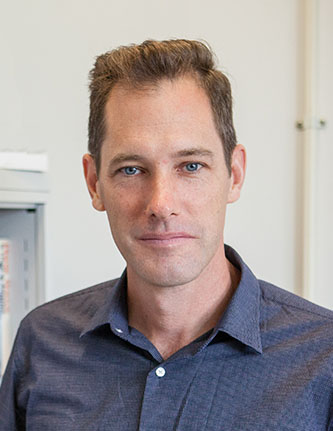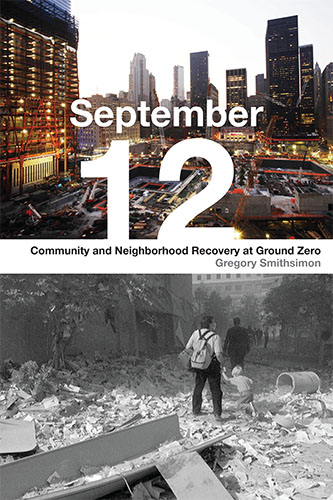Sociologist Gregory C. Smithsimon on the Legacy of September 11
Sept. 9, 2021

Professor Gregory C. Smithsimon

Cover of September 12: Community and Neighborhood Recovery at Ground Zero
Sociology Professor Gregory C. Smithsimon is an expert on urban sociology who encourages his students to embrace New York City and use it as a second classroom. He also has a unique perspective on the events of September 11. As the author of the book September 12: Community and Neighborhood Recovery at Ground Zero (NYU Press, 2011), he explores the tensions and social dynamics over memorials that developed between the residents of Manhattan’s Battery Park and the victims’ families. On the 20th anniversary of September 11, Smithsimon talks about its repercussions and how it changed everything from the demographics of downtown, to how buildings are constructed, and how New Yorkers cope through community.
How does September 11 factor into your courses and will this anniversary factor into your lessons?
I teach a lot of classes about New York City, as well as how to conduct qualitative research. All of my classes make use of New York City neighborhoods. I ask students, whether they’re writing papers or making short documentary films, to explore those neighborhoods during the semester.
The September 11 attacks were the worst thing that had happened in my life. It’s not the worst thing that has happened to many of my students, since most of whom were not born at the time. But many of them have lost family members to COVID-19 and spent more than a year in lockdown in small apartments. A lot of them live in neighborhoods that experienced flooding during events like Hurricane Sandy. It’s less about teaching about one event and more thinking about how you can work with communities that know something about going through extreme situations.
The sociological view, which is different from the Hollywood image of chaos and disorganization, is that you repeatedly see people using local networks and connections to respond and support each other at the neighborhood and community level. I don’t mean to idealize it, but students find that social structure remains important even in these exceptionally disruptive events.
Why did you write September 12? What were you hoping the book would add to the discussions surrounding the attacks?
Before September 11, I had been interested in how people create and use public spaces in New York—parks, plazas, street corners. It’s where we learn to be citizens, where we interact with people we don’t know and learn to negotiate the difficult business of sharing space with 8 million other people. I knew that people have something to say about the public spaces they use when there is a fight over them—when someone is trying to create, change, or destroy public spaces. That brings people out.
After September 11, New York was thrown into a recession. The only place anything was being built was related to the recovery around Ground Zero, so it was obvious that if I was going to look at how a city rebuilt itself and how people used public spaces, I was going to have to look there.
New Yorkers experienced a giant, collective tragedy, unlike the rest of the country, where September 11 was an international political issue. Here in the city, it wasn’t about a global war on terror. It was about friends who had died, firefighters who were missing at their station house, co-workers who were missing. It was about people who sometimes felt anxious, lonely, or depressed. So people talked about September 11 less in terms of the attacks, or the ideology, or the U.S. military response, and more about the smell of the smoke every day, the way people talked to strangers on the street, and places where missing persons signs were posted that eventually become public memorial spaces. I wanted to understand how people use the city they live in to respond and recover.
As I started following the recovery process, it became clear how beneficial it had been to downtown residents—and therefore survivors of other sorts of disasters—to be able to recover in place, in their communities. It made a huge difference that, in the months after the attack, if someone wanted to talk about things, they could walk outside, stop at a street corner or by a park bench, and have an informal conversation with someone they expected had experienced the same thing they had.
The sociologist of disasters Kai Erikson says that when people get displaced after a disaster—like a flood—the displacement constitutes a “second disaster.” We need to remember that people don’t just need emergency housing; they need to have a community in that housing that they can relate and connect to. As people get displaced by the rise of the sea level, for instance—that’s something we have to plan for, but almost none of the plans have been paid attention to.
Twenty years later, what do you feel remains the same or is different in relation to the work and research you did?
The city has changed a lot. Lower Manhattan is much more residential today: Most of Wall Street itself is luxury housing, not financial firms. The population of Battery Park City, the neighborhood that sits right next to the World Trade Center, has doubled as more high rises have been built. Most of the people who live there today weren’t there on September 11. They carry that day with them as part of their collective history, but most don’t remember being pitched into darkness in their apartments or fleeing a wall of smoke and ash as the towers fell.
The city is still highly unequal, and there are more challenges because of that. Inequality matters because it speaks directly to whether people have enough resources to respond to a disaster—the cost of job loss, housing loss, child care, loss of social support. Battery Park City did relatively well because it was richly endowed with good public spaces, a sympathetic public after September 11, and several years of rental support. People in poorer areas, like those hit hardest by storms or the pandemic, don’t necessarily get the level of support they need to allow them to keep up.
Many of my students today, who weren’t alive on September 11, may have experienced Islamophobia or known peers who fought in wars in Iraq or Afghanistan but not know people who worked in the towers.
What are the lasting lessons New York City residents learned all these years later? Do you think it changed the city for better or worse?
The response to September 11 was one of the first times extreme circumstances became part of everyday planning. Afterward, high-rises around the city had to improve the lighting and visibility in their exit stairways. New high-rises were built with bulky foundations to withstand bombings. September 11 influenced our planning for climate change, after Sandy and, more recently, during the COVID-19 pandemic. New Yorkers accept that we have to plan for extreme events that once seemed rare or unlikely. We’re not doing enough, but everyone accepts that planning doesn’t just account for normal conditions.
People think about extreme situations. Everyday people on the subway want to know what to do in an emergency, like if they are stuck in the tunnel or have to escape. And I believe that most New Yorkers have internalized that in an emergency, their safety depends on everyday civil servants—fire, first responders, subway crews. At the same time, they have seen what happens during an emergency—whether a terrorist attack or a hurricane—and know that help doesn’t come right away and at some level, people are responsible for themselves and each other.
Whether it’s a terrorist attack, a storm surge, or a pandemic, New Yorkers don’t say, “It can’t happen here.” They expect it will happen here, and they know the immediate response will happen in the midst of a lot of confusion. In the last 20 years, they’ve gotten used to hunkering down.
Watch Professor Smithsimon's Facebook Live with France 24 News from Ground Zero just two days before the 20th anniversary where he talks about the history and impact of September 11.






